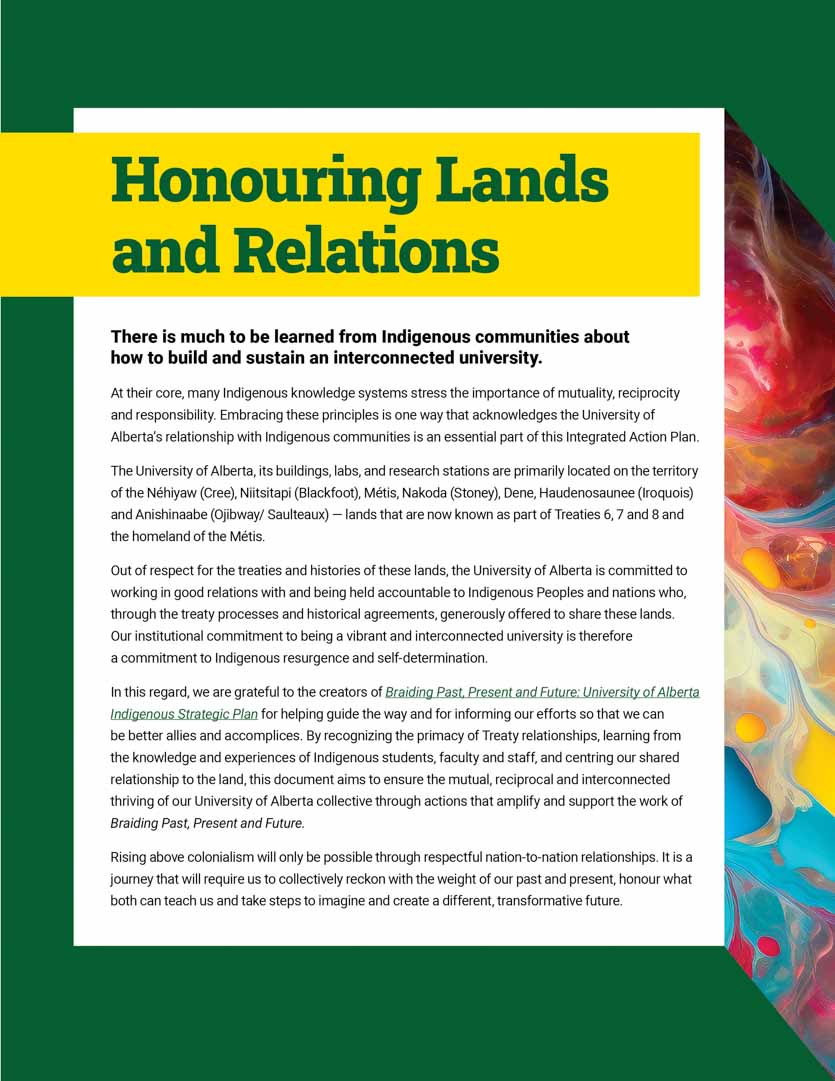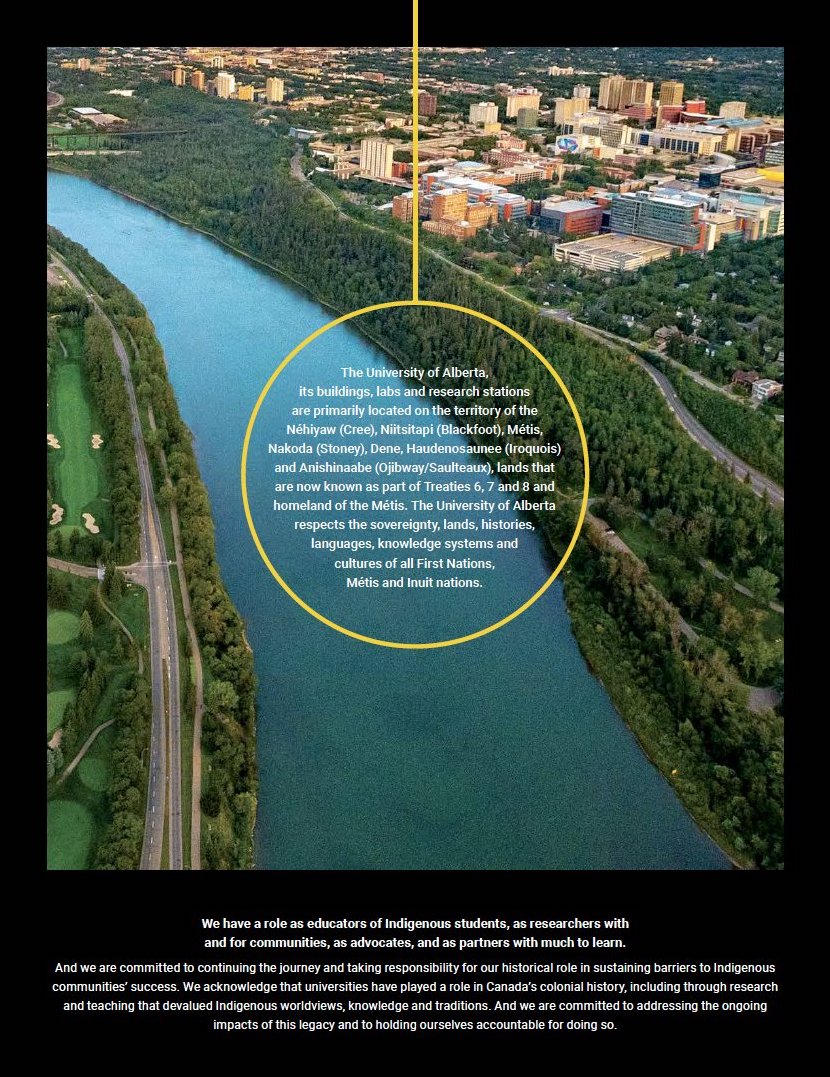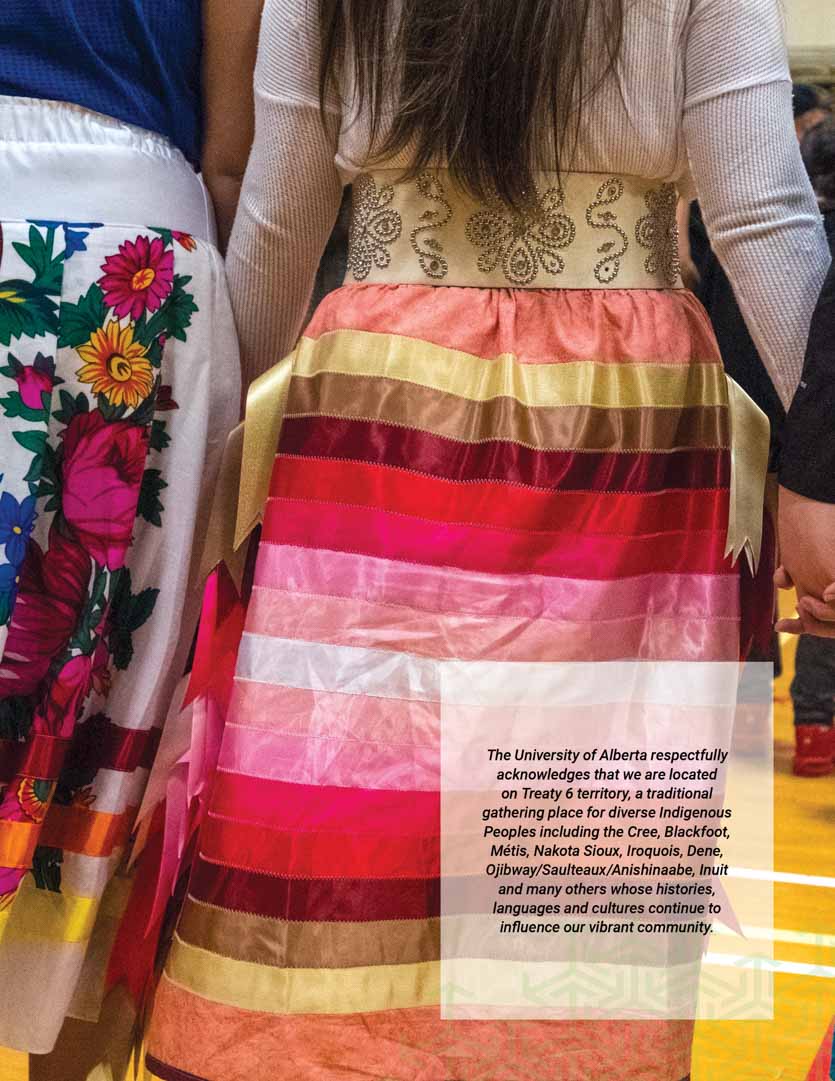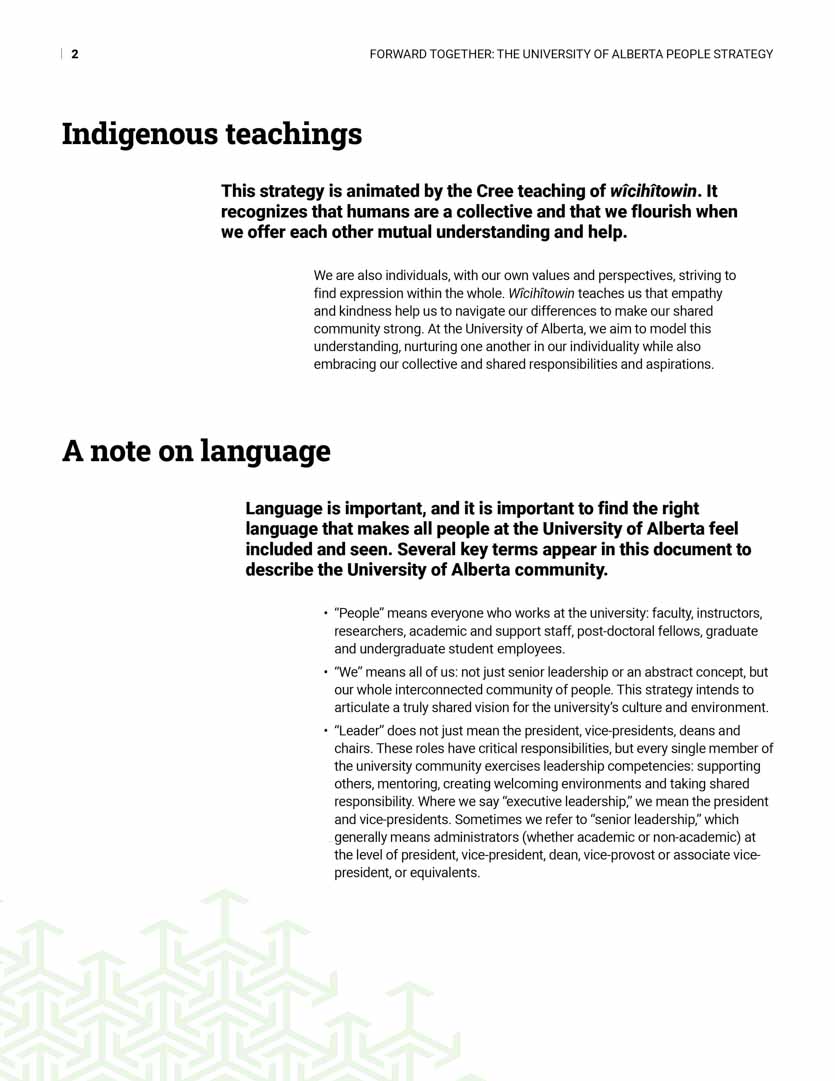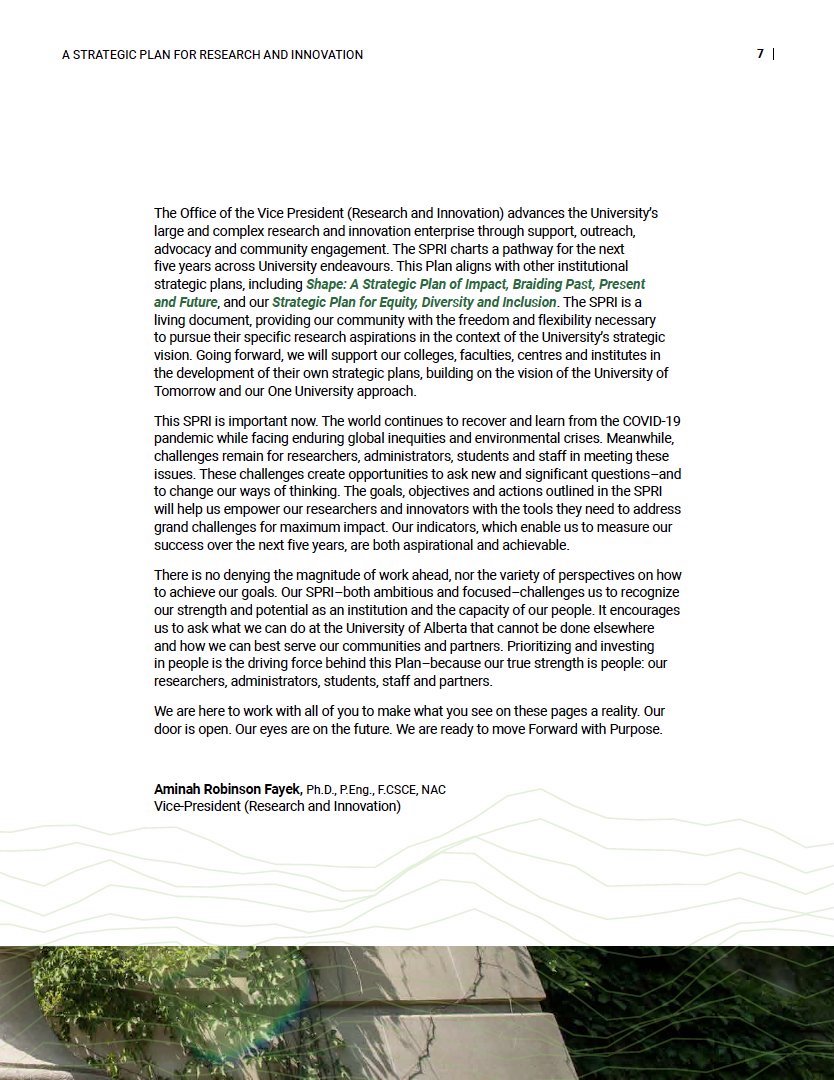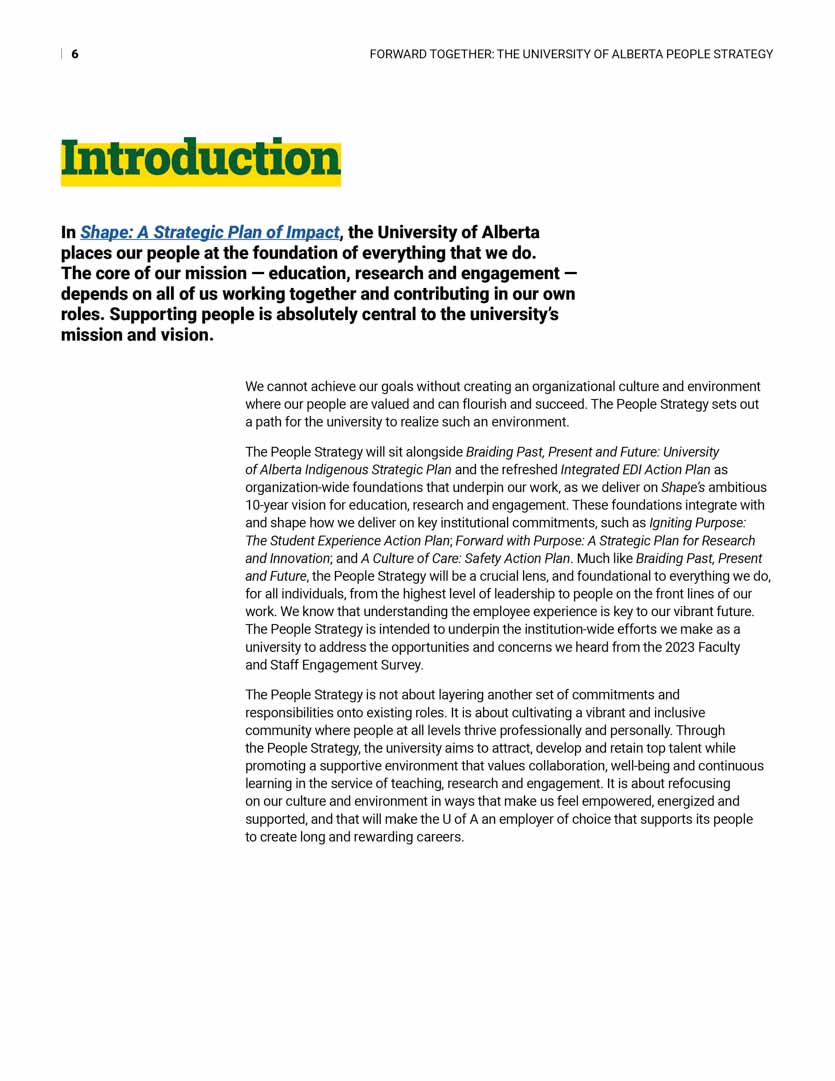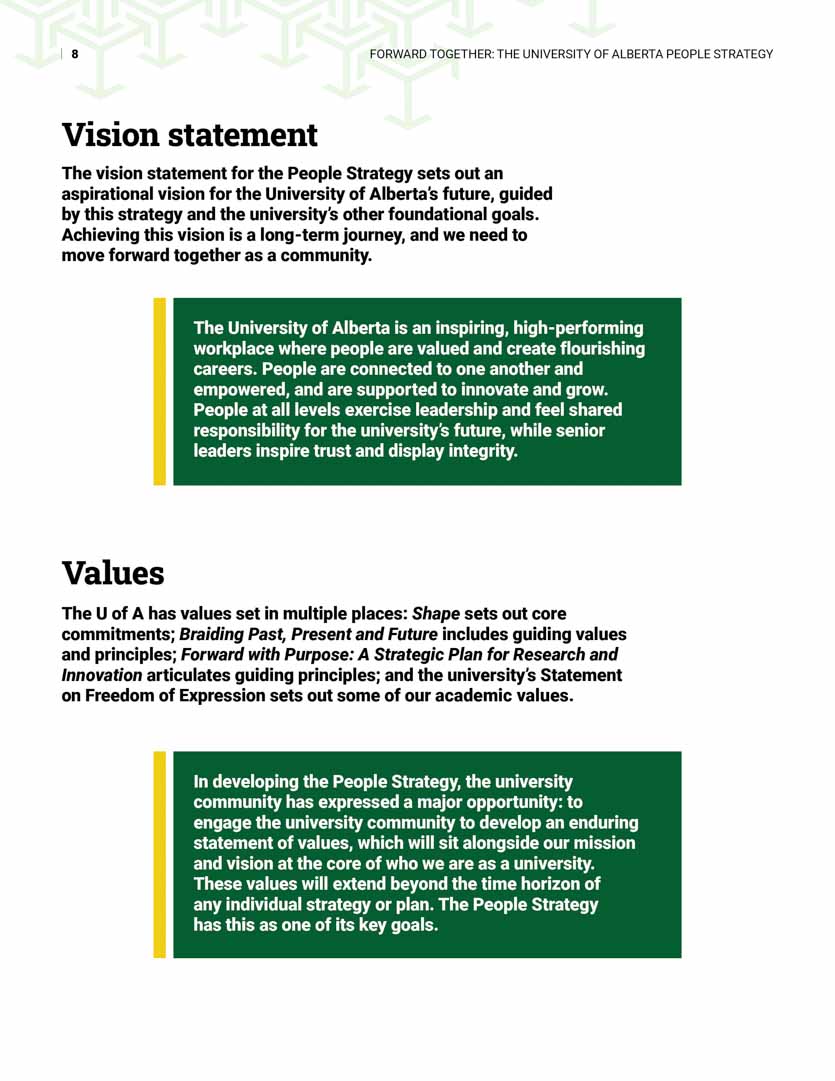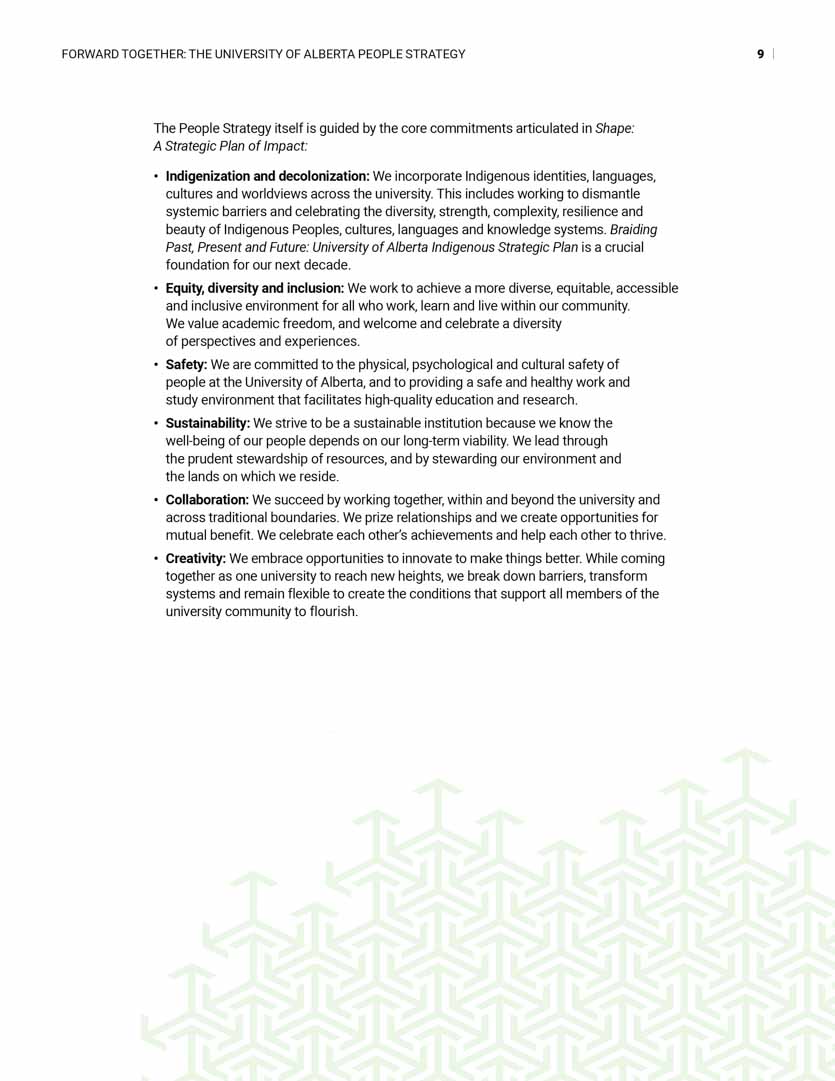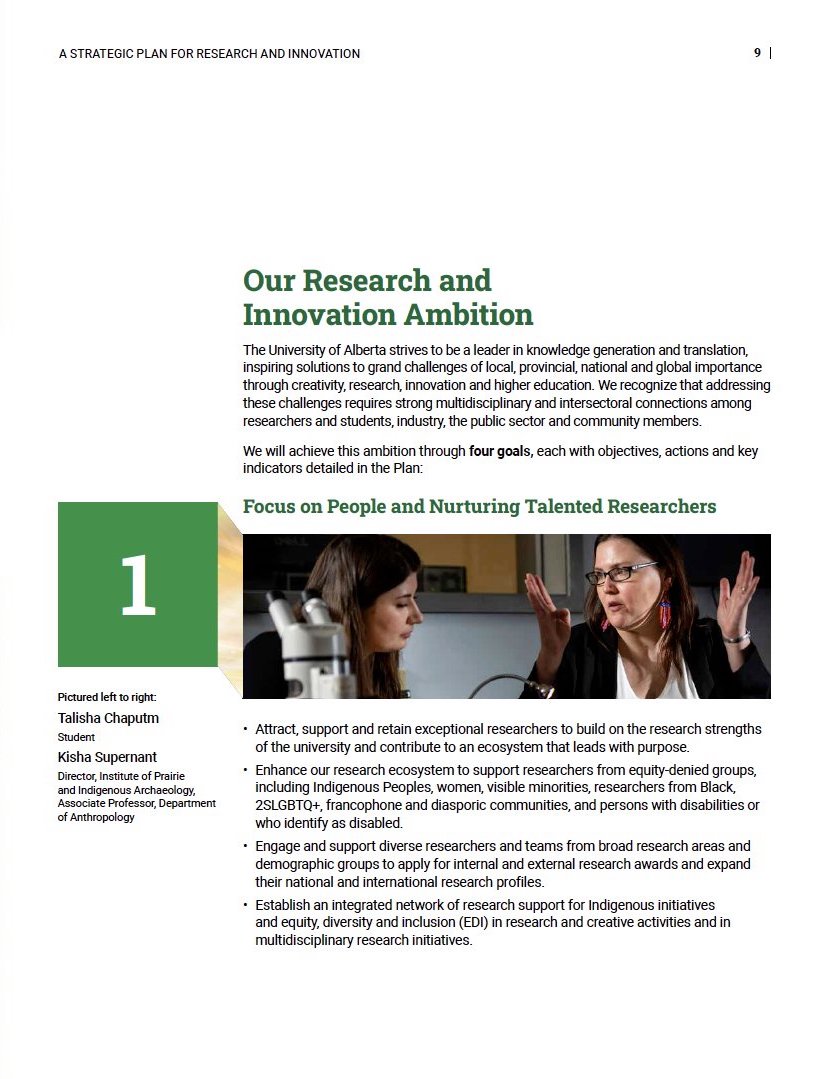Braiding strengthens teaching, learning, research and community engagement.
Alignment to Braiding
Since its release in 2022, the Indigenous-led direction offered in Braiding Past, Present and Future has been taken up in diverse strategies across the University of Alberta.
Colleges, faculties and portfolios at the University of Alberta are working to operationalize the accountabilities outlined in Braiding Past, Present and Future. This includes work across the institutional mandate – curricular change, research frameworks, student experience and policy development – among others. Explore the alignment between Braiding and the university’s other key strategic plans here.

- SHAPE: A Strategic Plan of Impact
2023 - 2033

- SHAPE: A Strategic Plan of Impact
2023 - 2033
Past Strategic Plans
Territorial Acknowledgement
The University of Alberta recognizes the significance of what it means to offer, and live out, the meaning of a territorial acknowledgment. The university is privileged to reside on Treaty lands. In the spirit of these agreements, the university upholds its commitment to working and living in good relation with each other, respecting the Indigenous Peoples and nations who, through the treaty process, generously offered to share these lands with those who came to these lands from far away.
See this theme reflected in:
The University of Alberta, its buildings, labs, and research stations are primarily located on the territory of the Néhiyaw (Cree), Niitsitapi (Blackfoot), Métis, Nakoda (Stoney), Dene, Haudenosaunee (Iroquois) and Anishinaabe (Ojibway/ Saulteaux) — lands that are now known as part of Treaties 6, 7 and 8 and the homeland of the Métis.
The University of Alberta, its buildings, labs and research stations are primarily located on the traditional territory of Cree, Blackfoot, Métis, Nakota Sioux, Iroquois, Dene and Ojibway/ Saulteaux/Anishinaabe nations; lands that are now known as part of Treaties 6, 7 and 8 and homeland of the Métis. The University of Alberta respects the sovereignty, lands, histories, languages, knowledge systems and cultures of First Nations, Métis and Inuit nations.
At the University of Alberta, creating a safe workplace across our One University is a multi-faceted issue that requires specific attention to several factors. Safety involves not only the physical environment, but also psychological and cultural well-being, which are equally critical aspects of feeling safe in the workplace.
The University of Alberta, its buildings, labs and research stations are primarily located on the territory of the Néhiyaw (Cree), Niitsitapi (Blackfoot), Métis, Nakoda (Stoney), Dene, Haudenosaunee (Iroquois) and Anishinaabe (Ojibway/Saulteaux), lands that are now known as part of Treaties 6, 7 and 8 and homeland of the Métis. The University of Alberta respects the sovereignty, lands, histories, languages, knowledge systems and cultures of all First Nations, Métis and Inuit nations.
We have a role as educators of Indigenous students, as researchers with and for communities, as advocates, and as partners with much to learn. And we are committed to continuing the journey and taking responsibility for our historical role in sustaining barriers to Indigenous communities’ success. We acknowledge that universities have played a role in Canada’s colonial history, including through research and teaching that devalued Indigenous worldviews, knowledge and traditions. And we are committed to addressing the ongoing impacts of this legacy and to holding ourselves accountable for doing so.
Rooted in the university’s deep commitment to equity, diversity and inclusion, we envision a university where everyone feels included and valued. Building on our work to advance truth and reconciliation, we envision a university that incorporates and honours Indigenous identities, languages, cultures and worldviews across the university.
The University of Alberta respectfully acknowledges that we are located on Treaty 6 territory, a traditional gathering place for diverse Indigenous peoples including the Cree, Blackfoot, Métis, Nakota Sioux, Iroquois, Dene, Ojibway/Saulteaux/ Anishinaabe, Inuit and many others whose histories, languages and cultures continue to influence our vibrant community.
The University of Alberta also acknowledges our enduring roots in the City of Edmonton, traditionally known as amiskwaciywâskahikan, which means Beaver Hills House in Cree. We view our location as an integral aspect of our identity, intertwined with our history, present engagements and future aspirations. Embracing our relationship with this vibrant community, the university strives to work together for the enhancement and betterment of the Edmonton region and beyond.
The University of Alberta, it’s buildings, labs and research stations are primarily located on the traditional territory of Cree, Blackfoot, Métis, Nakota Sioux, Iroquois, Dene, and Ojibwe/Salteaux/ Anishinaabe nations; lands that are now known as part of Treaty, 6, 7 and 8 and Homeland of the Métis. The University of Alberta respects the sovereignty, lands histories, languages, knowledge, systems, and cultures of First Nations and Inuit nations.
The University of Alberta respectfully acknowledges that we are located on Treaty 6 territory, a traditional gathering place for diverse Indigenous Peoples including the Cree, Blackfoot, Métis, Nakota Sioux, Iroquois, Dene, Ojibway/Saulteaux/Anishinaabe, Inuit and many others whose histories, languages and cultures continue to influence our vibrant community.
Indigenization & Decolonization
To tackle the erasure and colonization of Indigenous Peoples and Ways of Knowing, Being and Doing, the university is integrating Indigenous worldviews, languages, cultures and direction into diverse spaces. Explore more here.
See this theme reflected in:
There is much to be learned from Indigenous communities about how to build and sustain an interconnected university.
At their core, many Indigenous knowledge systems stress the importance of mutuality, reciprocity and responsibility. Embracing these principles is one way that acknowledges the University of Alberta’s relationship with Indigenous communities is an essential part of this Integrated Action Plan.
A history of the University of Alberta
2019: The position of Vice-Provost (Indigenous Programming and Research) is established.
2022: The U of A launches Braiding Past, Present and Future: University of Alberta Indigenous Strategic Plan.
Embracing Our Interconnectedness
We are, as we always have been, already interconnected. No matter what unit, college, faculty or department we study or work within, our research, teaching, administration, service, supervision, mentorship and communication activities have been impacted by interconnected pieces of the past and will go on to impact interdependent pieces of our future. “This,” as noted by the sociologist and activist Ruha Benjamin, “is what disability justice organizers have been trying to tell us, and what Indigenous peoples have long asserted — that whether we want to accept it or not, we are connected, not just to other living things but to those yet born …. Interdependence is not only part of a sacred philosophy but also a guiding ethos for refashioning social and political structures” (Viral Justice: How We Grow the World We Want, 2022, p. 9).
Improving the Ways We Share Knowledge
Action 1.8. Develop mechanisms to clearly articulate how the U of A statements on freedom of expression and academic freedom are operationalized for different roles within the University, and in relation to human rights, Treaty rights and collective agreements, including the responsibility to serve and teach all community members with dignity and respect.
Improving Cultures That Support Us
Action 2.10. Develop resources and coordinate strategies that enable all staff to learn about Indigenous, antioppressive, restorative, trauma-informed and emerging pedagogies and ways of working together.
Improving Cultures That Support Us
Action 4.4. Develop and launch ACB online learning modules and certification, as well as develop processes to encourage the uptake of these and related learning (e.g., Black Canadians, Indigenous Canada) for individuals, teams and committees (e.g., hiring, awards) looking to calibrate their professional development, activities or decisions around the principles of mutuality, reciprocity, responsibility and interdependence in order to increase success through access and belonging for all community members.
Since the release of the Truth and Reconciliation Commission’s Report in 2015, many people have been working to address the Calls to Action and build capacity for learning these truths and engaging in reconciliation. We recognize that Indigenous people continue to face entrenched hurdles, including bias and discrimination that impact their safety, health, well-being and ability to progress.
We incorporate Indigenous identities, languages, cultures and worldviews across the university. This includes working to dismantle systemic barriers and celebrating the diversity, strength, complexity, resilience and beauty of Indigenous Peoples, cultures, languages and knowledge systems. Braiding Past, Present and Future: University of Alberta Indigenous Strategic Plan is a crucial foundation for our next decade.
- We support Indigenous-led initiatives, knowledges, communities and research engagement, and take steps to deliver on the Truth and Reconciliation Commission of Canada’s Calls to Action, particularly, though not exclusively, in relation to Education for Reconciliation. We adhere to the guiding values and principles outlined in Braiding Past, Present and Future: University of Alberta Indigenous Strategic Plan. We are committed to the inclusion of Indigenous knowledges, voices and critiques, as well as physical and intellectual spaces that facilitate a plurality of Indigenous knowledges and practices.
Read more on page 21 - Our research excellence is underpinned by the principle of equity and the practices of inclusion and decolonization. By remaining accountable to these principles and practices, we strive to build a culture where diversity flourishes and where we work in partnership to dismantle systemic barriers with ethical integrity and social responsibility.
- We support Indigenous-led initiatives, knowledges, communities and research engagement, and take steps to deliver on the Truth and Reconciliation Commission of Canada’s Calls to Action, particularly, though not exclusively, in relation to Education for Reconciliation.
Other
- Deep relations with a rich tradition and connections to land. With campuses in both Edmonton and Camrose, and as the geographically northernmost U15 institution, our university offers a unique perspective in connection with a complex, biodiverse land and interconnected peoples. Our location enables us to learn from the rich traditions of First Nations, Métis, Inuit and all First Peoples of this place now called Canada, and to integrate those traditions into how we conceive, design and conduct research, recognizing the importance of genuine community engagement and participation at all stages of the process.
- Demonstrated uniqueness and strength in key areas [including] Indigenous research
We are all interrelated and interconnected, living, learning and working together for a balanced, supportive and healthy community with the land and with each other. An Indigenous worldview is a cornerstone of the action plan that goes beyond the inclusion of people who identify as First Nations, Métis and Inuit and instead provides a commentary on the vision for a healthy student experience from an Indigenous perspective.
An Indigenous worldview arose out of initial feedback from students that recognized the most positive aspects of the U of A student experience were in harmony with notions of kinship, balance, interconnectedness and community. As feedback grew more analytical, many identified principles of the Cree concepts of Wâhkôtowin and Miyo-pimâtisiwin, which encapsulate notions of healthy communities in the Cree worldview and helped to shape parts of the more multi-national Indigenous worldview sculpted for the plan. The SEAP staff sought feedback from Indigenous leaders on campus through teas, including thoughtful conversations with the Indigenous Advisory Council, which led to insights on ecological balance, ethics and ancestral knowledge that helped to solidify and ground the worldview. An Indigenous worldview affirms the vision and commitment of student experience through an Indigenous perspective familiar to those from Treaty 6, 7 or 8 territory and should resonate across cultures. The vision, commitment and Indigenous worldview statements are underpinned by our three principles (Connections are Fostered, Exploration is Essential and Challenge Accepted!) that emerged after the first cocreation workshop and encompass the desired future state of student experiences at the U of A. We recognize that within these principles, student experiences vary, and for some students, exceptional experiences are only attained after systemic barriers to equity and access are addressed.
This strategy is animated by the Cree teaching of wîcihîtowin. It recognizes that humans are a collective and that we flourish when we offer each other mutual understanding and help.
We are also individuals, with our own values and perspectives, striving to find expression within the whole. Wîcihîtowin teaches us that empathy and kindness help us to navigate our differences to make our shared community strong. At the University of Alberta, we aim to model this understanding, nurturing one another in our individuality while also embracing our collective and shared responsibilities and aspirations.
Alignment with Braiding
Braiding Past, Present and Future has been integrated into the university's key strategic plans.
See this theme reflected in:
In this regard, we are grateful to the creators of Braiding Past, Present and Future: University of Alberta Indigenous Strategic Plan for helping guide the way and for informing our efforts so that we can be better allies and accomplices. By recognizing the primacy of Treaty relationships, learning from the knowledge and experiences of Indigenous students, faculty and staff, and centring our shared relationship to the land, this document aims to ensure the mutual, reciprocal and interconnected thriving of our University of Alberta collective through actions that amplify and support the work of Braiding Past, Present and Future.
“Align Indigenous-focused policy work with revisions of the Equity, Diversity and Inclusivity (EDI) plan and implementation”
This action plan is built upon existing foundations and was developed with the current context of the university in mind.
Some key foundational pieces underway include: In 2022, the university launched a strategic plan to respond to the calls to action in the Truth and Reconciliation Commission of Canada’s final report. Titled Braiding Past, Present and Future: University of Alberta Indigenous Strategic Plan, the plan aims to dismantle colonial structures in the university that have long “disenfranchised Indigenous Peoples of their legal, social, cultural, religious and ethnic rights.”
As such, A Culture of Care supports the Braiding Past, Present and Future: University of Alberta Indigenous Strategic Plan. The five-year plan guides measures to ensure Indigenous identities, languages, cultures and worldviews are reflected in everything the university does. The plan includes concrete measures to reclaim Indigenous identity, languages, cultures and worldviews. Foregrounding the right to self-determination, the plan also makes clear that its goals — along with all Indigenous initiatives at the U of A — must be Indigenous led.
Significantly, all of our programs will meaningfully integrate our commitments reflected in Braiding Past, Present and Future — including to Indigenous Ways of Knowing, thoughtful community engagement and support for and value of Indigenous research
This Plan aligns with other institutional strategic plans, including Shape: A Strategic Plan of Impact, Braiding Past, Present and Future, and our Strategic Plan for Equity, Diversity and Inclusion.
Indigenous Worldview
The SEAP was also guided by the many student-focused actions in Braiding Past, Present and Future, the University of Alberta’s Indigenous Strategic Plan.
The People Strategy will sit alongside Braiding Past, Present and Future: University of Alberta Indigenous Strategic Plan and the refreshed Integrated EDI Action Plan as organization-wide foundations that underpin our work, as we deliver on Shape’s ambitious 10-year vision for education, research and engagement.
Values
The U of A has values set in multiple places: Shape sets out core commitments; Braiding Past, Present and Future includes guiding values and principles; Forward with Purpose: A Strategic Plan for Research and Innovation articulates guiding principles; and the university’s Statement on Freedom of Expression sets out some of our academic values.
The People Strategy itself is guided by the core commitments articulated in Shape: A Strategic Plan of Impact:
- Indigenization and decolonization: We incorporate Indigenous identities, languages, cultures and worldviews across the university.This includes working to dismantle systemic barriers and celebrating the diversity, strength, complexity, resilience and beauty of Indigenous Peoples, cultures, languages and knowledge systems. Braiding Past, Present and Future: the University of Alberta Indigenous Strategic Plan is a crucial foundation for our next decade.
Education with Purpose
Ensuring the increased participation of First Nations, Metis and Inuit learners is a key institutional priority. Explore more here.
See this theme reflected in:
- Increased participation in post-secondary education by Indigenous students, helping contribute to reconciliation
- Meet or exceed U15 benchmarks – total enrolment and total indigenous enrolment: Undergraduate and Graduate
Research with Purpose
Indigenous-focused research represents diverse opportunities and needs. The University of Alberta is committed to strengthening community-engaged research, increasing Indigenous participation in research and ensuring that research is ethical and informed by Indigenous Ways of Knowing. Explore more here.
See this theme reflected in:
- Identifying, nurturing and welcoming researchers from historically underrepresented and equity-denied groups, which will better position our academy to explore issues from a broader lens and allow ideas and creativity to flourish through diversity
- Building capacity to support and incentivize community-based research
- (Braiding) - Importantly, our initiatives will meaningfully integrate our commitments reflected in Braiding Past, Present and Future and our commitments to equity, diversity and inclusion.
- More robust and comprehensive research capacity through the durable embedding of Indigenous community engagement and Indigenous Ways of Knowing into research practices
More robust and comprehensive research capacity through the durable embedding of Indigenous community engagement and Indigenous ways of knowing into research practices.
The result will be a prevailing climate of support for researchers and research: one that fosters multidisciplinary engagement; provides safety in the pursuit of various lines of inquiry; integrates principles of equity, diversity, inclusion, decolonization and reconciliation; and centres collaboration in the generation and mobilization of knowledge.
- Enhance our research ecosystem to support researchers from equity-denied groups including … researchers from Indigenous … communities
- Expand collaboration among the Office of the Vice-President (Research and Innovation), the Office of the Provost and Vice-President (Academic), colleges and faculties to enhance funding opportunities for trainees and early-career researchers from equity-denied groups to increase researcher and faculty diversity.
- Create new, and engage existing, programs to expand research and training opportunities and communities for equity-denied groups.
- Create strategic workshops and training resources for targeted groups of researchers, including those from equity-denied groups and early-career researchers, to develop and strengthen research leadership and project management skills.
- Through collaborations among the faculties, colleges and centres and institutes, increase the number of university researchers from equity-denied groups who lead or co-lead large-scale, collaborative, funded, interdisciplinary research initiatives.
- Align strategic allocations of Canada Research Chair, Canada Excellence Research Chair and other chair and research professorship positions to increase the number of recipient researchers from equity-denied groups.
Engagement with Purpose
The University of Alberta is deeply committed to building and sustaining relationships of trust, respect and mutuality with Indigenous communities. Explore more here.
See this theme reflected in:
Coordinating Offices and Groups
This section of the ecosystem represents the mechanisms required for coordination between institutional priorities and mandates and the needs and insights shared by community members at all levels of the university. It includes the formal ways in which we gather. Those positioned within this section reflect a commitment to engage a plurality of voices and perspectives, support differing needs and amplify the work taking place in various locations. Examples of coordinating offices and groups that are included in this section of the ecosystem include: advisory and unit-level committees, departments, organizational teams, offices, networks and working groups; EDI Leads Network; Integrating Equity Group; Indigenous Advisory Council; Council on Systemic Ableism; Culture of Care Focus Group; Black-Led Research Network Initiative; Black Faculty Collective, to name a few.
Our situation on Treaties 6, 7 and 8 and the homelands of the Métis is fundamental to our identity, and we are deeply committed to building and sustaining relationships of trust, respect and mutuality with Indigenous communities.
- Proactively engaging with private, public and non-profit partners and with Indigenous communities to identify how our university can best advance the quality of life for all Albertans
- Sustaining and deepening our commitment to Indigenous communities, and embracing our responsibilities under the calls to action of the Truth and Reconciliation Commission of Canada
- Building capacity and incentives for our faculty, staff and students to collaborate and engage with communities, industry and social and cultural organizations
- Enhanced relationships and partnerships with First Nations and Métis communities within Alberta and an increase in Indigenous community-engaged research
Our relationships with Indigenous, rural, Francophone, local and national communities, industry and the land have cultivated innovative solutions to grand societal challenges.
1.2 Enhance our research ecosystem to support researchers from equity-denied groups including … researchers from Indigenous … communities
1.3 Engage and support diverse researchers and research teams from broad research areas and demographic groups to apply for internal and external research awards and expand their national and international research profiles.
- Strategically design internal research award processes and policies, incorporating, where applicable, Indigenous worldviews and furthering the principles of equity, diversity and inclusion (EDI).
- Recognize, support and celebrate research that is community-engaged, community-led, intersectional, francophone and partnered with Indigenous communities.
- Establish targeted internal awards to recognize and celebrate Indigenous scholars, scholars from equity-denied groups, research scholarship in the areas of Indigenous-engaged research and research that addresses and/or achieves greater levels of EDI.
- Strengthen capacity related to national and international research awards, ensuring that engagement and nomination processes are attentive to principles of Indigenous-led and Indigenous-engaged research and EDI.
1.4 Establish an integrated network of research support for Indigenous initiatives and equity, diversity and inclusion (EDI) in research and creative activities and in multidisciplinary research initiatives.
- Create an Indigenous research and innovation centre of expertise in the Office of the Vice-President (Research and Innovation).
- In collaboration with the Offices of the Vice-Provost (Indigenous Programming & Research) and the Vice-Provost (Equity, Diversity and Inclusion), develop and provide training and web-based tools on Indigenous initiatives and EDI to researchers as an integral element of research grant and ethics applications, including multidisciplinary research initiatives.
- Formally engage researchers in integrating Indigenous-engaged scholarship, research and relationships in relevant research grant and award applications.
3.3 Translate and mobilize knowledge, innovation, entrepreneurial research, research creation and creative works to enable, foster and support the formation of public, private and community partnerships.
- Build and support partnerships with municipal, provincial and national governments, Indigenous nations, not-for-profit organizations and the private sector to collaboratively develop and implement innovative, creative, artistic, entrepreneurial and commercial solutions to shared challenges.
- Develop relationships and collaborate with Indigenous, northern and equity-denied communities and civil society organizations to define and stimulate community-driven and community-led research and implementation programs.
Psychological and Cultural Safety
At the University of Alberta, creating a safe workplace across our One University is a multi-faceted issue that requires specific attention to several factors. Safety involves not only the physical environment, but also psychological and cultural well-being, which are equally critical aspects of feeling safe in the workplace.
See this theme reflected in:
Psychological safety means “a workplace that promotes workers’ psychological well-being and actively works to prevent harm to worker psychological health including in negligent, reckless, or intentional ways” (CSA National Standard, 2013). It is “the belief that one will not be punished or humiliated for speaking up with ideas, questions, concerns, or mistakes, and that the team is safe for interpersonal risk taking.” (Edmondson, 1999).
- Scarborough Charter
- Discrimination, Harassment and Duty to Accommodate
CULTURAL SAFETY
Cultural safety means an environment where employees can be their authentic selves. Employees should feel safe no matter how they identify as a human. University employees (and students) are diverse in their identities, including, but not limited to: gender, faith, mobility, linguistically and culturally. No employee should have to mask their authentic selves. Every employee should feel accepted and respected for who they are, in all of their complex identities and for the gifts that they uniquely contribute to the workplace.
- Indigenous Strategic Plan
- Strategic Plan for Equity, Diversity and Inclusivity
It is also acknowledged that safety is linked to the university’s infrastructure and its Integrated Asset Management Strategy (IAMS). The integration of initiatives such as the Indigenous Strategic Plan, the IAMS and this action plan will be achieved through the implementation planning process which will occur as the next stage of this project. Implementation of this plan will effectively bridge this gap from physical employee safety to the whole safety of the individual.
Braiding Past, Present and Future: University of Alberta Indigenous Strategic Plan
This plan reflects an important step in our institution’s commitment to reconciliation in post-secondary education, research and addressing the historical legacy of the residential school system and Canada’s colonial history in a meaningful and lasting way

